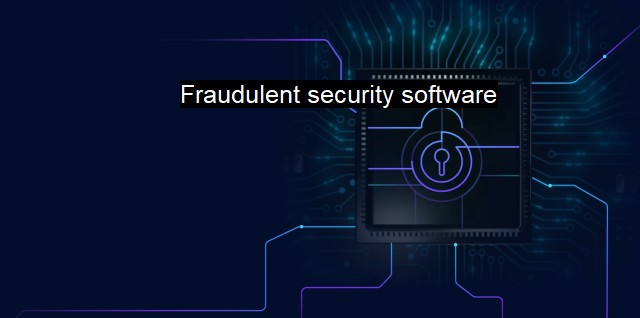What is Fraudulent security software?
Uncovering the Dangers Lurking Behind Scareware: A Look at Felonious Security Software
Fraudulent security software, often known as rogue security software or scams, is one of the biggest threats in the world of cybersecurity today. It is a form of internet fraud that uses manipulative and fear-driven tactics to trick users into installing, buying, or using bogus antivirus (AV) software varying widely in sophistication. Although they may assume an authentic appearance similar to reputable security applications, these malicious programs are strenuously designed to trick users into exposing their personal information or downloading harmful Roque malware onto their digital environment.In today's complex cybersecurity landscape, digital environments encompass several common rendezvous including computers, mobile devices, and other smart devices collectively wired across the internet of things (IoT) even extending to autonomous vehicles. These rogue security software applications harbor malicious activities which are detrimental, both in personal environments – including identity theft, unauthorized surveillance among others – and in corporate environments, resulting in tremendous financial damages, privacy breaches, and severe disruption of business activities.
Fraudulent security software often uses fear-based tactics, by delivering fictitious warnings of a supposed malware invasion to a user's device or network, hence “persuading” them to purchase and install the rogue software in order to “cleanup” the non-existent threats. Upon installation of the security software, the malware writers can perform any number of poisonous tasks, including kickstarting endless pop-ups, disabling reliable security software, scanning and tracking a user's activities to steal personal information.
Another common avenue by which the rogue software makes its way into systems is by masquerading as a legitimate antivirus tool on app stores, websites, and even advertisements. Failing to thoroughly inspect and confirm the authenticity of the AV software being downloaded broadens the scope of this form of cybersecurity threat. This is where the sophistication buttresses, the higher-end rogue security software often employ a “bait and switch” approach to further instill a fallacious sense of trust in users, by initially identifying and removing some low-level threats, only to later unleash more severe threats into the system.
The deceptive landscape of fraudulent security software demands more robust security initiatives. User's insurance lies in exercising vigilance in downloading or purchasing software online. Patronizing famous, reputable antivirus companies, bypassing email attachments or software download links from unfamiliar sources helps to diminish the chances of encountering this cybersecurity challenge.
Dispel any uncalled-for pop-up messages and always inspect the genuine warnings of your existing trusted security software if you own one. Occasionally, these rogue programs can trick users into thinking that their existing robust security software is in dire need of an urgent update, only to superimpose the user's reliable security solution with the pseudo one. Frequently update the operating system, browser, and install regular patches from the device manufacturer for better confrontation potential against such sneaky rogue software.
From a global perspective, fighting fraudulent security software involves a cooperative approach from reputable security vendors, who should intersect user awareness with comprehensive, technology-driven cyber threat intelligence in striving towards a progressively resilient digital environment.
Fraudulent security software poses a significant threat to personal and corporate cybersecurity, leveraging deceptive tactics to trick users into downloading harmful malware under the appearance of a false cure. Responsible digital environ conservation demands a proactive stance necessitating users to be vigilant about downloading, installing, or using any piece of antivirus software. For organizations, the deterrence entails prioritizing investments into secure and reliable security infrastructure, fostering a strong layer of user awareness, and sustaining an updated security environment.

Fraudulent security software FAQs
What is fraudulent security software?
Fraudulent security software, also known as rogue security software or scareware, is a type of malicious software that disguises itself as legitimate security software. It usually tricks users into buying unnecessary or fake antivirus software by presenting false security alerts and warnings.How does fraudulent security software work?
Fraudulent security software often spreads through malicious web pages, spam emails, or fake software updates. Once installed, it presents fake security warnings and pop-ups, claiming that the user's computer is infected with malware. Then, it offers a paid solution to remove the malware which is fake and unnecessary.How can I protect myself from fraudulent security software?
To protect yourself from fraudulent security software, you should always download security software from reputable sources and keep it up to date. Avoid clicking on pop-ups or links in unsolicited emails, and use caution when downloading software updates. Also, be wary of any unexpected security alerts or warnings and always verify the legitimacy of the software before making a purchase.What should I do if I suspect I have fraudulent security software on my computer?
If you suspect you have fraudulent security software on your computer, do not make any payments or follow any prompts from the software. Instead, try to uninstall the software from the control panel or using an antivirus software to remove the threat. You can also seek help from a professional cybersecurity expert to assist with removing the software and ensuring your system is secure.| | A | | | B | | | C | | | D | | | E | | | F | | | G | | | H | | | I | | | J | | | K | | | L | | | M | |
| | N | | | O | | | P | | | Q | | | R | | | S | | | T | | | U | | | V | | | W | | | X | | | Y | | | Z | |
| | 1 | | | 2 | | | 3 | | | 4 | | | 7 | | | 8 | | |||||||